OPEC and its allies held further discussions about changing the way they measure the impact of their production cuts, including proposals that would affect how quickly they hit their target, according to delegates from the group.
One option that OPEC and non-OPEC delegates discussed in Vienna on Monday is to continue measuring commercial oil inventories in developed economies against the five-year average, but without counting years of high stockpiles, the delegates said. Another option is to use a seven-year inventory average, they said. This would move their goal of reducing stockpiles to normal levels further from reach, potentially requiring a longer period of cuts to achieve it. Delegates also considered a period of more than seven years.
While the people said no final decision has been taken and the ultimate choice rests with ministers -- who didn’t attend the Vienna meeting -- the talks underscore the lingering uncertainty as the producers’ agreement enters a second year. They are going beyond their pledged cuts and crude has rallied above $60 a barrel, but there are signs that Saudi Arabia would like to go further.
Bloomberg news reports that when the Organization of Petroleum Exporting Countries, Russia and their allies struck a deal in 2016 to end the price slump and re-balance an oversupplied market, they set a target of bringing oil inventories held by members of the Organization of Economic Cooperation and Development back in line with the five-year average. After more than a year of supply curbs, they’ve made significant progress.
Stockpiles fell in February to around 44 million barrels above that measure, down from a surplus of 293 million barrels in January 2017, the first month of the cuts, said the people, who asked not to be identified because the meeting was private. Assuming current conditions remain the same, the delegates concluded that the market is on track to re-balance on the five-year measure in the second or third quarter.
However, Saudi Arabia and Russia, the two biggest producers taking part in this deal, have both previously said the five-year average is flawed. Years of excessively high supplies mean that measure is itself higher than normal, while the patchy nature of data outside the OECD makes it difficult to get an accurate picture of the entire world market.

















)